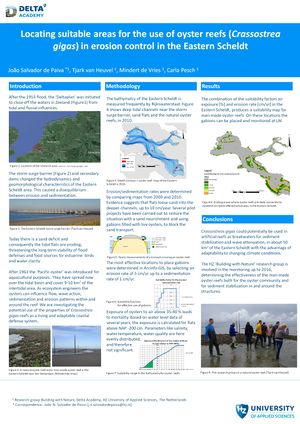Bijdrage HZ aan conferentie Littoral2014
Littoral 2014 is gehouden van 22-26 september in Klaipeda, Litouwen. Deze conferentie wordt om de twee jaar georganiseerd door het EUCC international office in samenwerking met een partner in een Europees land.
De HZ heeft in Klaipeda 2 dingen gepresenteerd. Ten eerste hebben 4 studenten DM in de workshop Climate of Coastal Cooperation de 'Visie Noord Beveland 2014' gepresenteerd, in het Engels. Ten tweede heeft de onderzoeksgroep BWN een poster gepresenteerd over de mogelijke locaties voor man-made oesterriffen in de Oosterschelde, gemaakt in het kader van het project Building with Living Nature.
Tekst in poster van het project Building with Living Nature
Locating suitable areas for the use of oyster reefs (Crassostrea gigas) in erosion control in the Eastern Scheldt
by: João Salvador de Paiva, Tjark van Heuvel, Mindert de Vries, Carla Pesch
- Introduction
After the 1953 flood, the ‘Deltaplan’ was initiated to close off the waters in Zeeland (Figure1) from tidal and fluvial influences. The storm surge barrier (Figure 2) and secondary dams changed the hydrodynamics and geomorphological characteristics of the Eastern Scheldt area. This caused a disequilibrium between erosion and sedimentation. Today there is a sand deficit and consequently the tidal flats are eroding, threatening the long term stability of flood defenses and food sources for estuarine birds and water clarity. After 1963 the ‘Pacific oyster’ was introduced for aquacultural purposes. They have spread now over the tidal basin and cover 9-10 km2 of the intertidal area. As ecosystem engineers the oysters can influence flow, wave action, sedimentation and erosion patterns within and around the reef. We are investigating the potential use of the properties of Crassostrea gigas reefs as a living and adaptable coastal defense system.
- Methodology
The bathymetry of the Eastern Scheldt is measured frequently by Rijkswaterstaat. Figure 4 shows deep tidal channels near the storm surge barrier, sand flats and the natural oyster reefs, in 2010. Erosion/sedimentation rates were determined by comparing maps from 2000 and 2010. Evidence suggests that flats loose sand into the deeper channels, up to 10 cm/year. Several pilot projects have been carried out to restore the situation with a sand nourishment and using gabions filled with live oysters, to block the sand transport. The most effective locations to place gabions were determined in Arcinfo-GIS, by selecting an erosion rate of 5 cm/yr up to a sedimentation rate of 1 cm/yr. Exposure of oysters to air above 35-40 % leads to mortality. Based on water level data of several years, the exposure is calculated for flats above NAP -200 cm. Parameters like salinity,
- Results
The combination of the suitability factors air exposure [%] and erosion rate [cm/yr] in the Eastern Scheldt, produces a suitability map for man-made oyster reefs. On these locations the gabions can be placed and monitored at LW.
- Conclusions
Crassostreas gigas could potentially be used in artificial reefs as breakwaters for sediment stabilization and wave attenuation, in about 50 km,sup>2</sup> of the Eastern Scheldt with the advantage of adaptability to changing climate conditions. The HZ ‘Building with Nature’ research group is involved in the monitoring up to 2016, determining the effectiveness of the man-made oyster reefs both for the oyster community and for sediment stabilization in and around the structures.
De poster
De poster is is als PDF-file te bekijken.
Zie ook
- Oesterdam sand nourishment - ecological and morphological development of a local sand nourishment
- Oyster reefs and coastal protection
- Building with Nature; from concepts to practice
- The efficiency of oyster reefs on coastal protection areas: Oesterdam case
- Ecosystem Services of constructed oyster reefs
- Understanding the morphological development of the Oesterdam nourishment
- Report of Workshop ‘Oesterdam suppletie’ held on 10th january 2012
- Building with living nature; conceptual elaboration
- The Benthic Ecosystem Quality Index (BEQI), intercalibration and assessment of Dutch coastal and transitional waters for the Water Framework Directive. Final report
- Rammegors tidal restauration, final report







